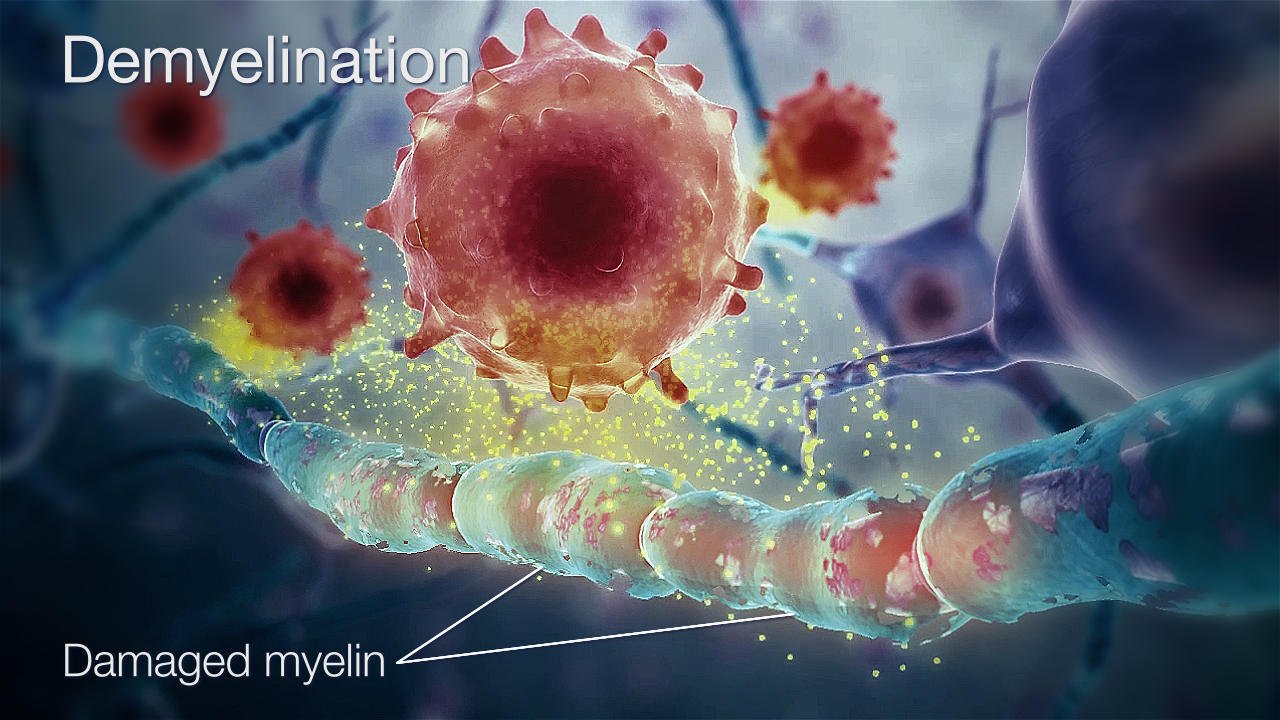Myelin is a protective layer that covers most of the nerves in our body. It is an insulating layer that helps messages from the brain move throughout the body quickly and smoothly. When myelin is damaged or worn away due to certain medical conditions, it is called demyelination and results in demyelinating diseases. When the myelin is damaged, scar tissue is formed in its place and since brain signals cannot move efficiently through scar tissue, the nerves do not work as well as they should.

Symptoms
The nerves are a very important part of the body function so any damage to them causes symptoms like numbness, dizziness, blurred vision or loss of vision, loss of bowel movement and bladder control, muscle stiffness and weakness, loss of reflexes, anxiety, depression and fatigue.
Causes
The exact cause of demyelination may not be very clear in many cases. But the most common causes are viral infections, lack of oxygen to the brain, hereditary factors, damage to blood vessels in the brain and autoimmune condition.
Types of demyelinating diseases
There are many types of demyelinating diseases.
- Multiple sclerosis (MS): This is the most common demyelinating disease. It is an autoimmune disorder that attacks the brain, spinal cord and optic nerves. Symptoms of MS are vision problems, trouble moving, fatigue, numbness, pain and tingling. There are four types of MS, which range from mild to severe. Women are likely to get more affected and may be caused due to genetic and environmental factors.
- Acute Disseminated Encephalomyelitis (ADEM): In ADEM, the myelin in the brain and the spinal cord gets damaged when the body attacks its own tissues in response to an infection. Children are more prone to get affected by this disorder. The symptoms are fever, nausea and vomiting, coordination problems, vision problems and headaches.
- Balo’s disease (concentric sclerosis): It is also considered as a rare form of MS because the symptoms are similar. Paralysis, fever, seizures, memory loss, muscle spasms and headaches occur. The cause for this disease is not known. It causes serious problems and may be fatal.
- Charcot Marie Tooth Disease (CMT): This condition is one which is inherited from one’s parents. It affects the peripheral nerves that are outside the brain and the spinal cord that send signals to the muscles in the limbs. Symptoms could show up any time from late teens until mid life. Trouble in walking and running, tripping, falling, weakness and loss of muscle mass in legs and feet, reduced sensation in legs and feet are all common signs of this disease.
- Guillain Barre Syndrome (GBS): In this condition also, the peripheral nerves are attacked. Symptoms begin with weakness in the legs that proceeds upwards to the arms and upper body and can result in paralysis. Other symptoms are tingling in fingers, toes, ankles, wrists, trouble speaking, moving the face or chewing, and bowel and bladder problems.
- HTLV-I Associated Myelopathy (HAM): In this condition, there is swelling in the brain and the spinal cord which is caused by a virus. The common symptoms are, weakness in legs, numbness, stiff muscles, tingling, bladder problems, double vision, constipation and coordination problems.
- Neuromyelitis optica: This is a rare condition in which the body attacks the optic nerve and the spinal cord, thereby affecting the eyes, arms and legs. Loss of eyesight, blurred vision, weak or numb arms and legs and bladder and bowel movements are some of the symptoms.
- Transverse Myelitis: This is a spinal cord disorder. Symptoms could occur anywhere in the body depending where on the spinal cord the myelin has been damaged or lost. Women are more likely to get affected. The exact cause is not known but it mostly follows after an infection. Some people suffer long lasting effects, while others recover quickly. Symptoms include bladder and bowel problems, muscle weakness, problem in moving legs, numbness or tingling in toes, fatigue, lower back pain and sensitivity to touch.
Treatment
There is currently no full cure for demyelinating diseases. Most treatments try to lessen the effects of the attack, manage the symptoms and control the course of the disease with the help of medications that can reduce the pain and stiffness of the muscles. Physical therapy is also used to help with the muscles that are affected.
New Myelin growth can occur in areas where the myelin has been damaged. But it is not as protective as the old myelin and the transmission of electrical impulses is not as efficient as before. Research is on for ways for the body to grow healthy and protective myelin once it is damaged.
Disclaimer: The information in no way constitutes, or should be construed as medical advice. Nor is the above article an endorsement of any research findings discussed in the article an endorsement for any of the source publications.
Sources-
- https://www.mayoclinic.org/diseases-conditions/multiple-sclerosis/expert-answers/demyelinating-disease/faq-20058521
- https://www.webmd.com/multiple-sclerosis/what-are-demyelinating-disorders
- https://www.msdmanuals.com/en-in/professional/neurologic-disorders/demyelinating-disorders/overview-of-demyelinating-disorders









